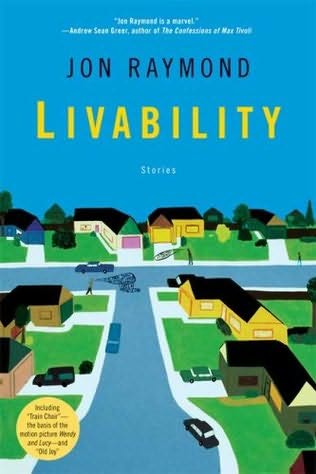By Jonathan Raban
The New York Times Book Review
Wendy and Lucy
a film by Kelly Reichardt, adapted from a story by Jon Raymond

Livability: Stories
by Jon Raymond
Bloomsbury, 260 pp.

In the imaginary America of books and movies, where every state and region has acquired a rich cluster of meanings and associations over time, the Pacific Northwest is a fairly recent arrival. Nineteenth-century painters like Albert Bierstadt visited Oregon and Washington in search of fresh landscapes to add to their stock of images of the sublime, and the explicitly social vocabulary of late Romantic sublimity ("noble," "regal," "grand," "majestic," and all the rest) still gets attached to the region's extravagant volcanic geography, its mountain ranges, evergreen forests, and superabundance of water in every form. In the second half of the twentieth century, that geography came to serve as backdrop to the unmajestic, ignoble life in the valleys and foothills, where low-rise, makeshift, ad hoc settlements stand in plain view of the snowcaps and forest, mockingly diminished by their spectacular surrounding nature.
Bernard Malamud—who taught at Oregon State College, now Oregon State University, in Corvallis, from 1949 to 1961—conveyed this beautifully in A New Life (1961), a novel in which the college town of Easchester in the state of Cascadia is a scale model of McCarthy-era, small-minded social, academic, and political conformity, set in a landscape whose mountains, tumbled clouds, and vast sky hold out the promise of exhilarating escape and freedom to S. Levin, "formerly a drunkard," of New York City. Since then, in the stories of Raymond Carver, the films of Gus Van Sant, and the novels of Ken Kesey and David Guterson, among others, the Pacific Northwest has become familiar as the place in America where lives of grimly straitened circumstances play out within sight of the now-ironic sublime. The old-growth Douglas firs, the mountains and cascades are there to tease from a distance: it's in the trailer homes and bungalows below, in insufficient, straggling towns, their single highways lined with the parking lots of big-box stores, that most Northwest fiction happens.
These drab lowlands, mostly shot under a wan, overcast sky, are the setting for Wendy and Lucy, directed by the Florida-born, New York–based independent filmmaker Kelly Reichardt. Like her last movie, Old Joy (2006), Wendy and Lucy is adapted from a short story by the Portland, Oregon, writer Jon Raymond, whose intently observant and unillusioned take on his home territory has been adopted by Reichardt as her own. In their latest collaboration, Raymond and Reichardt have turned the Great Pacific Northwest, as its boosters call it, into an allegorical landscape of economic and emotional recession; a world starved of credit, jobs, futures, sunlight, words, and social bonds. The December 2008 release of Wendy and Lucy, after a successful season on the festival circuit, was eerily well-timed: it would be hard to find a more powerful illustration of Obama's talk of the danger of financial crisis turning into catastrophe than this spare and haunting film.
To Read the Rest of the Review Essay
No comments:
Post a Comment